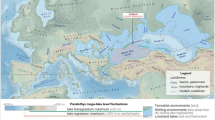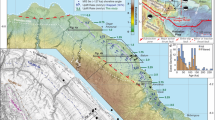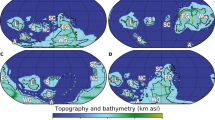Abstract
The extent of dry land during post-Carboniferous time seems to have fluctuated about a constant mean—no secular decrease in marine inundation of the continents can be identified. Such a decrease was first proposed by Egyed1, who tried to show, with palaeogeographical measurements, that the seas have withdrawn steadily during the Phanerozoic; he deduced on this basis that the Earth is expanding. The idea of an expanding Earth has had little support2, but the steady marine recession seems to be more widely accepted. Hallam3, for example, confirmed Egyed's finding, and explained it as arising from orogenesis. My new estimate of the extent of the dry land, however, casts doubt on these earlier results, largely by taking into account continental drift and the progressive extension of shelf seas around the young Atlantic and Indian Oceans.
This is a preview of subscription content, access via your institution
Access options
Subscribe to this journal
Receive 51 print issues and online access
$199.00 per year
only $3.90 per issue
Buy this article
- Purchase on Springer Link
- Instant access to full article PDF
Prices may be subject to local taxes which are calculated during checkout
Similar content being viewed by others
References
Egyed, L. Geofis. pura appl. 33, 42–48 (1956); Nature 178, 534 (1956).
Glikson, A. Y. Geology 7, 449–454 (1979).
Hallam, A. Nature 269, 769–772 (1977); 232, 180–182 (1971).
Wise, D. U. in The Geology of Continental Margins (eds Burk, C. A. & Drake, C. L.) 45–58 (Springer, New York, 1974).
Vail, P. R., Mitchum, R. M. Jr & Thompson, S. III Am. Ass. petrol. Geol. Mem. 26, 83–97 (1977).
Armstrong, R. L. Nature 221, 1042–1043 (1969).
Davies, G. F. J. geophys. Res. 85, 2517–2530 (1980).
Turcotte, D. L. & Burke, K. Earth planet. Sci. Lett. 41, 341–346 (1978).
O'Nions, R. K. & Pankhurst, R. J. Earth planet. Sci. Lett. 38, 211–236 (1978).
Cook, F. A. et al. Geology 7, 563–567 (1979).
McKenzie, D. Earth planet. Sci. Lett. 40, 25–32 (1978).
Sclater, J. G. & Christie, P. A. F. J. geophys. Res. 85, 3711–3739 (1980).
Southam, J. R. & Hay, W. W. J. geophys. Res. 82, 3825–3842 (1977).
Harrison, C. G. A. et al. EOS 61, 1124 (1980).
Bond, G. Geology 6, 247–250 (1976); J. Geol. 86, 47–65 (1978).
Schlee, J. S. Prof. Pap. P1167 (US Geological Survey, Reston, Virginia, 1980).
Sheridan, R. E. in The Geology of Continental Margins (eds Burk, C. A. & Drake, C. L.) 391–407 (Springer, New York, 1974).
Baker, B. & Miller, J. Nature 199, 346–348 (1963).
Blant, G. (ed.) Sedimentary Basins of the African Coasts, Pt 2, South and East Coasts (Association of African Geology Surveys, Paris, 1973).
Hayes, D. E. (ed.) Antarctic Oceanology II: The Australian-New Zealand Sector, Antarctic Res. Ser. 19 (American Geophysical Union, Washington DC, 1972).
Nairn, A. E. M. & Stehli, F. G. (eds) The Ocean Basins and Margins Vol. 1 (Plenum, New York, 1973).
Theron, J. C. in Gondwana Geology (ed. Campbell, K. S. W.) 61–74 (Australian National University Press, Canberra, 1975).
Veevers, J. J. & Cotterill, D. Bull. geol. Soc. Am. 89, 337–355 (1978).
Smith, A. G. & Briden, J. C. Mesozoic and Cenozoic Palaeocontinental Maps (Cambridge University Press, 1977).
Termier, H. & Termier, G. Histoire Géologique de la Biosphère (Masson, Paris, 1952).
Elliott, D. H. Am. J. Sci. 275A, 45–106 (1975).
Petters, S. W. J. Geol. 86, 311–322 (1978).
Hallam, A. J. Geol. 79, 129–157 (1971).
Harrington, H. J. Bull. Am. Ass. petrol. Geol. 46, 1773–1814 (1962).
Barron, E. J., Sloan, J. L. II & Harrison, C. G. A. Palaeogeogr. Palaeoclimatol. Palaeoecol. 30, 17–40 (1980).
Morel, P. & Irving, E. J. Geol. 86, 535–561 (1978).
Ziegler, A. M. et al. Tectonophysics 40, 13–51 (1977).
Holmes, A. Principles of Physical Geology 2nd edn, 968–970 (Nelson, London, 1965).
Briden, J. C., Drewry, G. E. & Smith, A. G. J. Geol. 82, 555–574 (1974).
Nelson, A. B. Rand Pap. P-5612 (Rand Corporation, Santa Monica, 1976).
Author information
Authors and Affiliations
Rights and permissions
About this article
Cite this article
Cogley, J. Late Phanerozoic extent of dry land. Nature 291, 56–58 (1981). https://doi.org/10.1038/291056a0
Received:
Accepted:
Issue Date:
DOI: https://doi.org/10.1038/291056a0
This article is cited by
-
The Earth's early hydrosphere
Nature (1982)
-
Ctenodactylid rodents in the Miocene Negev fauna of Israel
Nature (1982)
-
Phanerozoic land–sea and albedo variations as climate controls
Nature (1982)
Comments
By submitting a comment you agree to abide by our Terms and Community Guidelines. If you find something abusive or that does not comply with our terms or guidelines please flag it as inappropriate.



